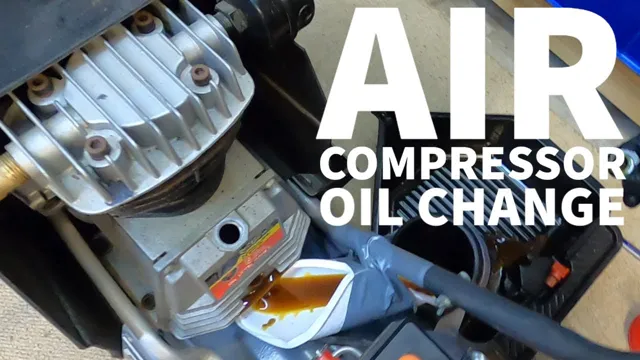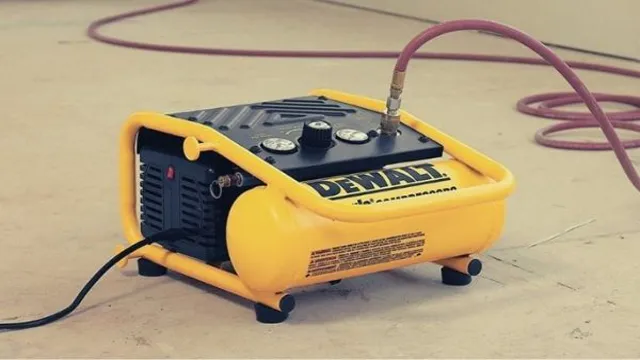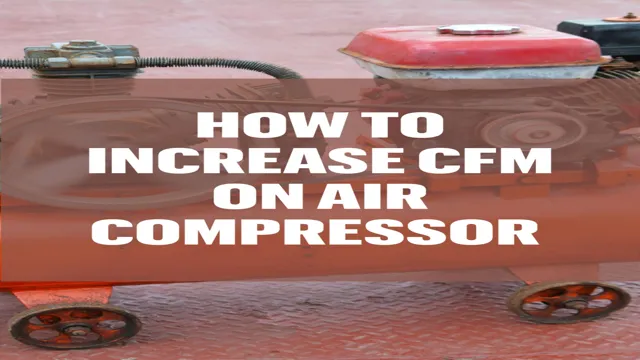
If you’re frustrated with your air compressor’s attachment but aren’t sure how to change it, fear not! It may seem daunting at first, but with a few simple steps, you can easily swap out an old or faulty attachment for a new one. Perhaps you need to switch from a manual to an automatic air hose reel or replace a worn-out air hose altogether. Whatever the reason, we’ve got you covered with this helpful guide on how to change attachments on your air compressor.
So grab a cup of coffee, put on your work gloves, and let’s get started!
Preparing for the Attachment Change
Changing the attachment on your air compressor can be a simple process. The first step is to prepare by turning off the power and unplugging the compressor. Then, carefully disconnect the old attachment from the air hose.
Once this is done, examine the threads on the hose and the new attachment to ensure they match. If they don’t, you may need an adapter. To attach the new piece, wrap thread seal tape around the threads on the hose end and screw the new attachment on, making sure it’s tight.
Finally, turn on the power and test your new attachment by running the compressor for a few minutes. By following these steps, you can easily change the attachment on your air compressor and be ready for your next DIY project or professional job.
Step 1: Turn Off the Air Compressor
When preparing for an attachment change on your air compressor, the first step you should take is to turn off the compressor. This may seem like common sense, but it’s essential to ensure your safety while working on the machine. By shutting off the compressor, you eliminate the risk of any sudden bursts of air or accidental starts while changing attachments.
It’s also crucial to allow the compressor to cool down before starting any work. This will prevent any potential burns from hot parts and allow for a smoother attachment change process. So, when getting ready to change your air compressor’s attachment, make sure to take the time to turn off the machine and let it cool down properly.
These simple steps will help keep you safe and ensure a successful attachment change.

Step 2: Release Air Pressure from the Tank
To change attachments on your air compressor, it’s essential to start by releasing the air pressure from the tank. This step is crucial for your safety as it prevents the compressor from starting unexpectedly during the attachment change. First, shut off the power source and unplug the compressor.
Then, open the valve on the air tank and let the air out slowly until the gauge reads zero. Next, remove the air hose from the tank, and make sure the pressure relief valve is not clogged. It’s essential to check that the air pressure is entirely released before moving onto the next step to avoid accidents or damages to the compressor.
With the air pressure released, you can safely proceed to the attachment change process, ensuring it is done smoothly and efficiently. Remember, safety always comes first when dealing with air compressors.
Step 3: Select the New Attachment
After extracting the old attachment, it’s time to prepare for the attachment change. This involves selecting the new attachment that will replace the old one. It’s crucial to ensure that the new attachment is compatible with the file format and meets the required specifications.
This selection process requires attention to detail, as selecting the wrong attachment could lead to compatibility issues, delays in completing the task, or even damage to the system. Therefore, it’s recommended to consult the user manual or seek assistance from the manufacturer or technical support to select the appropriate attachment. With the right attachment in hand, you are one step closer to completing the task at hand and achieving your desired outcome.
Remember, selecting the correct attachment is key to ensuring a smooth and successful process.
Removing the Old Attachment
Changing the attachment on an air compressor can be a daunting task if you don’t know what you’re doing. First things first, you’ll need to remove the old attachment. Start by turning off the compressor and unplugging it from the power source.
Next, locate the attachment that you want to remove. Usually, it will be attached with screws or bolts. You may need a wrench or screwdriver to remove the attachment.
Make sure to hold onto the attachment securely as you remove the screws or bolts. Once the screws or bolts are removed, you should be able to gently remove the attachment from the compressor. Be careful not to damage any of the components around the attachment as you remove it.
Once the old attachment is removed, you can proceed with installing the new one. It’s always a good idea to consult the user manual or seek the assistance of a professional if you’re not confident in your abilities.
Step 1: Identify the Type of Attachment
To remove an old attachment, the first step is to identify the type of attachment being removed. This will help determine the best method to use when eliminating the attachment. There are various types of attachments, including bolts, screws, clips, and pins, among others.
Each of these attachments has a specific removal method that should be followed to avoid damage to the item being repaired or the attachment itself. Some attachments, such as screws and bolts, can be easily removed using a screwdriver or wrench. However, others may require special tools, such as pliers or a pry bar.
Care should be taken when removing the attachment so as not to cause any damage or further complications. By identifying the type of attachment being removed, the process can be made easier, and the risk of damage or injury minimized.
Step 2: Loosen the Fittings
To remove the old attachment, the second step in the process is to loosen the fittings. The fittings are what connect the attachment to the main equipment, and they can be found at both ends of the attachment. Before loosening the fittings, it is important to turn off the power supply to the equipment to ensure safety.
Once this has been done, you can use a wrench or pliers to carefully loosen the fittings. It is important to be gentle to avoid damaging the fittings or the attachment itself. The fittings may be tight, but with patience and a little force, they should come undone smoothly.
Once the fittings have been loosened, carefully detach the old attachment from the equipment and set it aside. Remember to store it safely, as it may be useful in the future. With the old attachment out of the way, you can now move on to the next steps of installing the new attachment.
Step 3: Remove the Old Attachment
Now that you have identified the old attachment you want to replace, it’s time to remove it. This step can vary depending on the type of attachment and how it was installed, but there are basic steps you can follow. First, turn off the power source to avoid any electrical shock or injury.
If it’s an attachment that is screwed on, use the right tool to loosen it counterclockwise. If it’s glued on, use a heat gun or adhesive remover to loosen the grip. Be careful not to damage the surface or surrounding area.
If it’s a larger attachment, you may need an extra set of hands or a dolly to safely remove it. Once you have removed the attachment, clean the area thoroughly with a damp cloth or cleaning solution to prevent any residue or debris from affecting the installation of the new attachment. Remember to dispose of the old attachment properly.
This step may seem simple, but it’s crucial to ensure the new attachment is installed safely and properly.
Installing the New Attachment
Replacing the attachment on your air compressor is a simple task that can be completed in just a few minutes. The first step is to turn off your compressor and release any built-up pressure. Next, remove the old attachment by unscrewing it counterclockwise.
Once removed, take your new attachment and screw it onto the compressor clockwise until it is tightly secured. Be sure to check that the new attachment is compatible with your compressor before making the switch. By following these steps, you can easily and safely change the attachment on your air compressor, ensuring optimal performance for all your projects.
So, the next time you need to switch attachments, don’t hesitate to do it yourself.
Step 1: Connect the New Attachment
When installing a new attachment, the first step is to connect it to the machine or device. This may seem like an obvious step, but it’s important to ensure that you do it correctly to avoid any issues later on. Start by examining the new attachment and locating any attachments or connectors that need to be connected to your machine.
Make sure the power is turned off before you begin, and then carefully attach the new piece to your machine. Double-check to ensure that it is firmly attached and secure before moving on to the next step. By taking your time and being careful during this first step, you can ensure that the new attachment is correctly installed and ready to use.
Step 2: Tighten the Fittings
Once you have attached the new fitting to the pipe, the next step is to tighten the fittings to make sure they don’t leak. To do this, you’ll need to use a wrench or pliers to tighten the nut on each end of the fitting. Don’t overtighten, though, as this can damage the fittings.
A good rule of thumb is to tighten until it feels snug, and then give it a quarter turn more. Test for leaks by turning on your water supply and checking for any drips or puddles. If there are no leaks, you’re good to go.
If there are, try tightening the fittings a bit more until the leaks stop. Remember, a properly installed attachment should be snug, but not so tight that you strip the threads or damage the pipe.
Step 3: Test the Air Compressor
Now that you have installed the new attachment on your air compressor, it’s time to test it out and make sure everything is working properly. Testing the air compressor is an important step, as it can help you avoid potential issues down the line. To start, turn on the compressor and allow it to run for a few minutes.
As it runs, use a pressure gauge to test the air pressure coming out of the compressor. You should see a steady flow of air, without any fluctuations or drops in pressure. If the pressure is not consistent, it may be a sign of a problem with the compressor or the attachment.
Additionally, be sure to check for any leaks in the air hoses or fittings, as this can also cause pressure issues. By testing your air compressor, you can ensure that it’s working properly and ready for use whenever you need it.
Conclusion
In conclusion, changing the attachment on your air compressor is like switching up your outfit for the day. You want to make sure you’re using the right tool for the job, but you also want to have some fun and style points along the way. With a few simple steps and a little bit of know-how, you can swap out your compressor’s attachment like a pro.
So go ahead, try out that new spray gun or nail gun attachment and show off your DIY skills. Your air compressor will thank you for it!”
FAQs
How do I remove the current attachment on my air compressor?
To remove the current attachment on your air compressor, first, make sure the compressor is turned off and unplugged. Then, locate the attachment release lever or button, press it down or pull it out, and carefully remove the attachment.
Can I use any attachment on my air compressor?
No, you cannot use any attachment on your air compressor. Different compressors are designed to work with specific attachments, and using an incompatible attachment can damage both the attachment and the compressor.
How do I find the right attachment for my air compressor?
To find the right attachment for your air compressor, first, check the owner’s manual or manufacturer’s website for compatible attachments. You can also consult with a technician or check with a hardware store specializing in compressors.
What should I consider when choosing a new attachment for my air compressor?
When choosing a new attachment for your air compressor, consider the size and type of the compressor, the type of job you plan to use it for, and the compatibility of the attachment with your compressor.
Can I attach multiple attachments to my air compressor at once?
No, it is not recommended to attach multiple attachments to your air compressor at once as this can cause damage to the compressor. Use only one attachment at a time.
How do I properly secure the attachment to my air compressor?
To properly secure the attachment to your air compressor, make sure it is aligned with the inlet or outlet port, push the attachment into the port until it clicks or locks into place, and check that it is secure before using the compressor.
How often should I change the attachment on my air compressor?
The frequency of changing the attachment on your air compressor will depend on how frequently you use it and the type of job you are doing. Regularly inspect the attachment for any signs of wear or damage, and replace it as needed to ensure safe and efficient operation.








